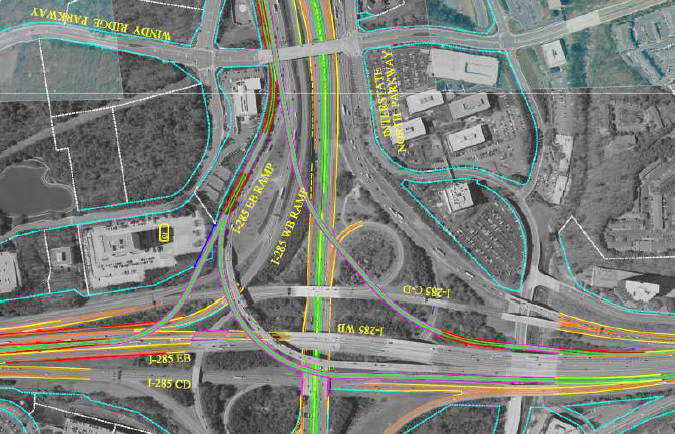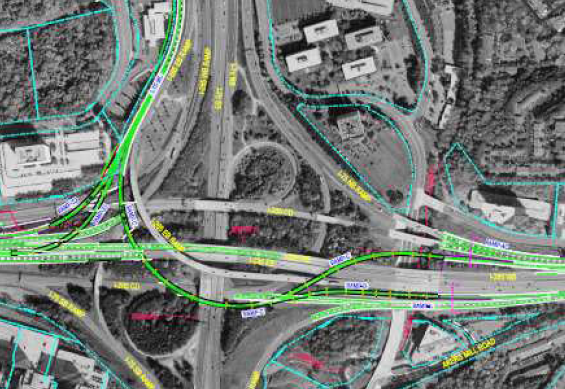by Mike Ososki, PMP, Communications Committee
You may call it a road, but to Georgia DOT, it's "horizontal transportation." Last Monday, three of GDOT's best graced our dinner meeting with a comprehensive case study summary of one of their largest projects: The Northwest Corridor, which is 30-miles of road starting at I-75/I-285, heading north to I-575 and a little more. Definitely not a commuter favorite during rush hour—and that's why our heroes are working hard to come to the rescue! Thank you to GDOT's Albert Shelby, John Hancock, and Albert Welch for
representing.
Project benefits include more travel options, time-saving and reliable trip times, better transit service support, and enhanced economic growth for the area.
In the GDOT structure, funded at ~$2B/year, there are two separate Offices: "Program Delivery" and "Innovative Delivery." The program folks deal with Design-Bid-Build projects, while the innovation team works with Design-Build and innovative financing. For STIP delivery (State Transportation Improvement Program), both are involved with preliminary engineering, ROW (right-of-way)
acquisition, and construction.
One of GDOT's top priorities is to manage risk, defined as "any factor that may interfere with the successful completion of a project." You can only imagine how much governmental, environmental, design, utility, right-of-way, and funding risk is involved in the Northwest Corridor project's current $834M estimated cost. The JV team of NWER (Northwest Express Roadbuilders) is the contractor, and construction starts this October, projected to go into the summer of 2018. NWER scope is to design, construct, and provide partial funding. This helps accelerate delivery and shifts certain risks from the state to the contractor.
Project features include Peach Pass tolling, barrier-separated reversible lanes accessed via controlled barrier gates, slip ramps (also known as service roads or access roads alongside the expressway), and express lanes.
Innovations were another top priority. In addition to the features noted above, the DBF (Design-Build-Finance) procurement is a first for GDOT, and many ATC's (Alternative Technical Concepts inspired by the private sector) have been incorporated for cost savings of ~$60M. These include alternatives for bridge designs, barriers and walls, roadway construction details, and lifecycle lighting cost.
 |
 |
|
| Proposed Alternative Alignment at I-75/I-285 | Approved ATC – Alternative Alignment at I-75/I-285 |
The TIFIA Credit Program (Transportation Infrastructure Finance and Innovation Act) provided a $275M loan to help make it all happen.
- State-of-the-art tolling technology will be used to maintain ~45mph flow in express lanes
- All electronic submission process between NWER and GDOT, to improve accountability, accessibility, and auditability
- Proactive permit process
- Quality management material testing and inspection risk entirely with NWER
- Accelerated ROW acquisition process
Project management steps for the Northwest Corridor project include:
- Plan: Determine feasibility
- Procure: Delivery method, finance options, private sector partner
- Design-Build: Expedite review and decision-making for fast-paced overlapping design and construction, meeting FHWA (Federal Highway Administration) requirements.
Due to the extensive complexity of the Design-Build phase, consultant groups assist GDOT and SRTA (State Road and Tollway Authority) with technical, legal, and financial advice and recommendations. Consultant specialties include SME's for project management, NEPA (National Environmental Policy Act), submittals review, and ROW. Tight coordination and clear, timely communication is strongly emphasized between all parties so as to minimize bad surprises.
Again, the vision is to reduce congestion, provide more reliable travel times, and help improve air quality. The public has demonstrated a high level of support, and the vibrant economic development in the area will be enhanced, along with the quality of life for area residents.
(Note: Thanks to Steve Maraboli for the article title :))

